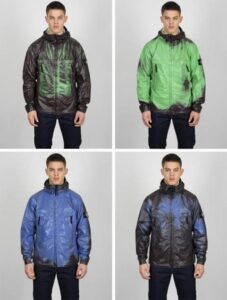
The latest Gen Z TikTok trend: Heat-reactive fashion
Italian luxury brand Stone Island announced a capsule collection of heat-reactive pieces in April. The concept was simple but full of visual payoff: Puffers, flasks, and windbreakers are treated with a thermo sensitive coating, meaning the items change color in response to the slightest influx of heat from direct contact. The pieces were TikTok gold.
Suddenly and all at once, fashion creators on the app were torching their heat-reactive gear with hair dryers, capturing the ephemeral tie-dye effects for viewers. Twenty-three-year-old content creator Jack Lawrence, who lives just outside of London, invested heavily in the trend. He purchased a Stone Island jacket (more than $1,000) and a secondhand pair of special-edition Nike S.B. Dunks (which fetch more than $500 on StockX). “It’s not really my style, but I was like, Wow, this might be something that catches people’s eye,” says Lawrence. The investment paid off. There was a large audience for the content: Multiple videos indulging in the magic of heat-reactive pieces have racked up more than 300,000 views.

“TikTok really thrives on satisfaction,” says Lawrence, who frequently uploads videos that spotlight viral fashion releases (like the Ben and Jerry’s x Nike shoe). He likens his heat-reactive videos to ASMR content. “Watching something like that is so satisfying for viewers,” he says. “People are so fascinated by it.”
The rise of heat-reactive content illustrates the current landscape of influencer fashion. Even if the techno-fabric fails to cross over from our phones to the streets in meaningful ways, the micro-trend offers a glimpse at how visually stunning styles can motivate, and reward, creators. Algorithms on social media are governed by what catches our attention. So it makes sense then that the fashion most popular on TikTok skews toward fabrics and colors that glimmer, shine, dance, and transform. The wardrobes, and trends, popular there are built for virality.
But can heat-reactive fashion become an everyday sighting? This is not the first time the idea has been proposed.
Heat-reactive technology, more officially called thermo-chromatic ink, first captured the public’s attention in the early ’90s, when an emphasis on futuristic-feeling fashion reigned. London teen Charlie Jones—a 19-year-old who recently started Phase London, a skatewear brand made by and sold to Gen Z’ers—discovered, through product research, the former popularity of color-changing JeansWest Hypercolor pieces at raves. The short-lived line actually built its entire brand around the heat-reactive technology, selling tees printed with lines like “Touch Me.” The frenzy of high sales only lasted for a year (a lot longer than most of today’s TikTok trends). The company filed for bankruptcy in 1992.
Agustina Panzoni, a trend forecaster and content creator on TikTok, says the heat-reactive trend could foreshadow a Y2K-flavored rise in garments that encourage transformation and personalization. This makes sense, given the items’ former popularity in the ’90s. Users online are posting tributes to vintage modular pieces, like the fall 2004 Issey Miyake sleeping-bag puffer jacket.
Heat-reactive pieces tap into this nostalgia. “I think the heat-reactive trend is part of a wider movement in fashion championed by TikTok creators—cocreation,” Panzoni explains, pointing to pieces that encourage interaction and participation from wearers. (See: convertible pants-shorts.) “We see it in the popularity of creators who make clothes out of everyday objects.”
Now a number of smaller brands are attempting to tap into the visual satisfaction, including Di Petsa, which crafted a tight-fitting leather dress that turns blue when touched. And Central Saint Martins grad Pip Paz-Howlett, a noted fan of incorporating homoeroticism into his work, tapped into the sensual side of the technology with heat-reactive underwear.
Jones recently released a tee that featured a heat-reactive logo, standing out from the pack by having a select part of the garment feature the technology rather than the entire piece. Jones was inspired to create the white logo tee—which features dark green text that turns lime green when heated—after he discovered a company, SFS Supplies, that sold heat-reactive ink in bulk. Jones placed an order and then enlisted a supplier to make 250 shirts and apply the ink. “I spent quite a lot of money on the T-shirts with the risk that it might not work at all,” Jones says. “I just made the full order and said, ‘If it works, it works, and if it doesn’t, it doesn’t.’” Thankfully, the heat-reactive tees were a technical — and financial — success. All 250 sold out quickly.
Jones says he has many more heat-reactive pieces in the pipeline, including a hoodie for next season. He calls the items “kind of a gimmick,” but says, “they’re a great way to promote my brand.”
Time will tell if bars and skate parks become filled with people wearing heat-reactive gear. There are some practical concerns about the fabric—sweat stains showing up as multicolored blotches being number one. But fans of heat touch like Jones say they are keen to see if the trend truly sticks next winter, when the technology works better. When asked about the arc of the trend, Panzoni says, “I’m unsure how long interest in heat-reactive fashion will last, but I do think consumers will still look for more cocreation opportunities in the future.”
Lawrence, meanwhile, says he’s already moved on to the next trend; he recently resold his Nike S.B.s at a break-even rate. He’s currently interested in tech-fleece garments—the activewear fabric popular among football-loving lads in the U.K. The trend pulls in millions of views.
Culled from Vogue
